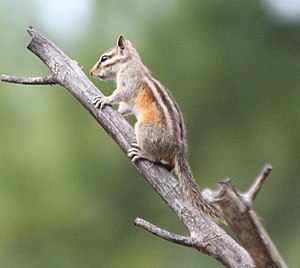Gray-necked chipmunk
| Gray-necked chipmunk | ||||||||||||
|---|---|---|---|---|---|---|---|---|---|---|---|---|

Gray-necked chipmunk ( Tamias cinereicollis ) |
||||||||||||
| Systematics | ||||||||||||
|
||||||||||||
| Scientific name | ||||||||||||
| Tamias cinereicollis | ||||||||||||
| JA Allen , 1890 |
The gray-necked chipmunk ( Tamias cinereicollis , syn .: Neotamias cinereicollis ) is a type of squirrel from the genus of the chipmunk ( Tamias ). It occurs in parts of Arizona and New Mexico in the United States .
features
The gray-necked chipmunk reaches an average head-trunk length of 20.8 to 24.3 centimeters, the tail is significantly shorter at 8.0 to 11.3 centimeters. The fur of the animals is pale orange to cinnamon, on the back there are - as is typical for the species - five dark brown to black back stripes, which are separated by lighter stripes. The flanks below the lowest brown stripes are reddish brown. There are two noticeable light stripes on the face, which are outlined in brown. The belly side is white to light sand-colored. The cheeks, the neck, the shoulders and the trunk are pale gray, the tail is washed through gray with orange-brown parts.
distribution
The gray-necked chipmunk is found in parts of Arizona and New Mexico in the United States .
Way of life
The gray-necked chipmunk lives in the open areas and the edge zone of pine , spruce and fir stands at high altitudes of the distribution area, which are characterized by a moderate and evenly humid microclimate. At lower altitudes, the animals prefer pine, Douglas fir and oak - juniper stands.
The species is diurnal and primarily living on the ground, however, as good climbers, gray-necked chipmunks also climb trees and look for food there. The animals feed mainly on the herbivorous seeds of herbs and grasses, the cones of the conifers, beechnuts, fruits, mushrooms and parts of green vegetation, rarely also on insects. Sometimes supplies are gathered and camps are made between piles of wood or in tree hollows and crevices in the rock. They can hibernate or fall into a short torpor in extremely cold temperatures , which is interrupted on warmer winter days. The main period of activity is between March and November, when they spend the day outside the nest; in winter they only come out of the nest on warm days. The nests are created under piles of wood, tree stumps and roots, occasionally the animals also use abandoned woodpecker holes in tree trunks. The animals often sit upright on their hind legs on piles of wood or tree stumps and watch their surroundings. If there is no threat, they signal this with calm “chucks”, but if there is danger they utter a high-pitched and clipped scream.
The breeding season is in late spring to early summer. The females throw four to six, usually five, young animals in the first half of June after a gestation period of 30 days. These are suckled by the females for 41 to 45 days and come out of the nest for the first time at the end of July.
Systematics
The gray-necked chipmunk is classified as an independent species within the genus of chipmunks ( Tamias ), which consists of 25 species. The first scientific description comes from Joel Asaph Allen from 1890, who introduced the species on the basis of individuals from the San Francisco Peaks in Coconino County , Arizona. Within the chipmunk group, the gray-necked chipmunk is assigned to the subgenus Neotamias , which is also discussed as an independent genus, together with most of the other species .
Within the species, two subspecies are distinguished with the nominate form :
- Tamias cinereicollis cinereicollis : nominate form; occurs in east-central Arizona and New Mexico.
- Tamias cinereicollis cinereus : occurs in west-central New Mexico. Compared to the nominate form, the subspecies is somewhat paler and more gray and has small reddish spots.
Status, threat and protection
The gray-necked chipmunk is classified by the International Union for Conservation of Nature and Natural Resources (IUCN) as “least concern”. This is justified with the comparatively large area of distribution and the regular occurrence, there are no potential risks to the existence of the plant. The species benefits from moderate logging and a thinning of the forests, but the complete loss of forests led to a local decline in populations.
supporting documents
- ↑ a b c d e f g h Richard W. Thorington Jr. , John L. Koprowski, Michael A. Steele: Squirrels of the World. Johns Hopkins University Press, Baltimore MD 2012; Pp. 320-321. ISBN 978-1-4214-0469-1
- ↑ a b c Neotamias cinereicollis in the IUCN Red List of Threatened Species 2015.3. Listed by: AV Linzey & NatureServe (G. Hammerson), 2008. Retrieved November 24, 2015.
- ↑ a b Tamias (Neotamias) cinereicollis In: Don E. Wilson , DeeAnn M. Reeder (Ed.): Mammal Species of the World. A taxonomic and geographic Reference. 2 volumes. 3. Edition. Johns Hopkins University Press, Baltimore MD 2005, ISBN 0-8018-8221-4 .
- ↑ Joel Asaph Allen : A review of some of the North American ground squirrels of the genus Tamias. Bulletin of the American Museum of Natural History 3, 1890; Pp. 45-116. ( Full text , description of the species on pp. 94–96)
- ↑ Bruce D. Patterson, Ryan W. Norris: Towards a uniform nomenclature for ground squirrels: the status of the Holarctic chipmunks. Mammalia 80 (3), May 2016; Pp. 241-251 doi : 10.1515 / mammalia-2015-0004
literature
- Richard W. Thorington Jr. , John L. Koprowski, Michael A. Steele: Squirrels of the World. Johns Hopkins University Press, Baltimore MD 2012; Pp. 320-321. ISBN 978-1-4214-0469-1
- Clayton D. Hilton, Troy L. Best : Tamias cinereicollis. Mammalian Species 436, 1993.
Web links
- Neotamias cinereicollis inthe IUCN Red List of Threatened Species 2015.3. Listed by: AV Linzey & NatureServe (G. Hammerson), 2008. Retrieved November 24, 2015.
